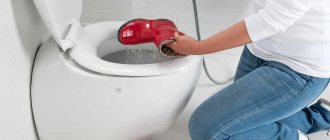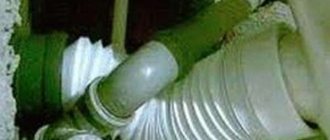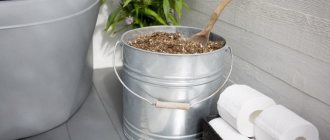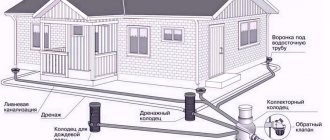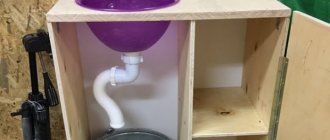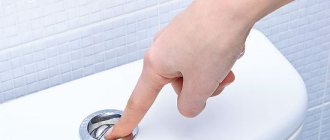Connecting a hygienic showerInstalling a hygienic shower in the toilet
Installing a hygienic shower is a good alternative to a bidet. If you do not have the opportunity to install a bidet in the bathroom, but there is a need for it, then installing a hygienic shower will be the way out. The device is compact, but no less convenient. A hygienic shower differs from a regular shower in the size of the shower head and in that it is made of a special material coated with chrome, which does not allow the accumulation of dirt and dust.
Hygienic shower is divided into the following categories:
1) Installation of a hygienic shower in the seat - toilet lid; 2) Installation of a hygienic shower built into the toilet; 3) Hygienic shower installed next to the toilet on the sink; 4) Installation of a hygienic shower using a mixer (external or built into the wall);
The most common among our consumers is a shower connected to a sink or shower mixer (if there is no sink). This is due to the fairly inexpensive price and variety of models presented on the market of plumbing equipment. The hygienic shower includes: a watering can, a hose and a mixer. If you do not have the opportunity to install a sink in the toilet room, then you should use a faucet with a hygienic shower without a spout.
When you open the shower, water will immediately flow into the hose and watering can. On the watering can itself there is a special valve, when pressed, water begins to flow, and when you release it, the water stops flowing
It is very important to remember that after taking hygiene procedures, the tap must be closed, otherwise it will end in a flood. If you have a sink, you will need a faucet with a spout that has an outlet for connecting a shower.
By opening the faucet, water will flow into the sink, and by pressing the valve, water will flow from the watering can. Installing a hygienic shower significantly saves space, which is very important for small toilet rooms.
A hygienic shower can be installed in the toilet room at any time without resorting to renovation of the bathroom. The hygienic shower is connected to existing communications. Water is connected both from the sink and from the hot and cold water risers, as well as the water supply passing through the toilet room. Experienced plumbers advise purchasing a wall-mounted hygienic shower with an open installation method.
The advantages of a hygienic shower are that you do not need to move from place to place (as is the case with a bidet) and there is significant space saving. Some people believe that installing a hygienic shower is not necessary, but if several people live in an apartment, then a hygienic shower is a good alternative to a bathroom.
In any case, an experienced plumber will always tell you which of the hygienic shower options is right for your toilet room.
Positive characteristics of devices
Comparing lids with a bidet function, hygienic showers and other devices for personal hygiene in the toilet with a primitive watering can, it is not difficult to highlight the positive qualities of such designs, in particular:
- Variations in water pressure and temperature modes in various combinations, which is important for those who ask how to use a hygienic shower for men. With such a device, taking into account the anatomical features of the body structure of men and women, you can choose the best option for carrying out procedures.
- Possibility of adjusting the direction of water jets.
- Change settings and switch to user mode.
- Additional functions in the form of liquid aeration for greater comfort.
- Massage functions performed according to special programs with changes in pressure and a number of other parameters for comfortable use of the device.
- Built-in hairdryer option for effective yet gentle drying. The corresponding mode allows you to adjust the air temperature that is comfortable for the user. However, such models are more expensive than others.
- In standby mode, the shower, equipped with electronics, switches to energy saving mode. The user's presence nearby is detected thanks to the built-in motion sensor.
- Self-cleaning function for spray tips.
- Before supplying water for washing, filters built into the system remove mechanical impurities, changing the level of water hardness, which makes feminine and men's hygiene more pleasant.
- The ability to saturate the air coming from the hygienic hair dryer built into the design with pleasant aromas. In addition, deodorizing solutions are supplemented with disinfectants that destroy pathogenic bacteria and a number of other harmful organisms.
- Adjustable seat lowering level thanks to a smart custom settings system.
- Maintaining optimal pressure is ensured thanks to the built-in pump, and increasing and maintaining the water temperature thanks to an autonomous system, so you can only connect a hygienic shower to a cold water supply line.
The above advantages allow the potential buyer to understand whether it is convenient to use a hygienic shower in the toilet and, based on this, make a choice.
Now, having familiarized yourself with the features and variations in the functioning of a hygienic shower, it will be easier for you to choose the option of sanitary ware for personal hygiene from a wide range of products on the market.
Recommendations for selection
Plumbing and sanitary ware stores offer almost all types of hygienic showers. All that remains is small: choose the type of shower, material of manufacture, design and quality. When purchasing a device, consider the following features:
Device design. Some models do not allow connecting to two pipes at the same time, then the output is only cold water. Method of attachment. Sometimes, when mounted on a wall, residual drops are found on the shower head that flow onto the floor Product material
Give preference to brass with a chrome-plated surface, this option is the most durable in use. Study the demand on the market, always choose the price-quality ratio, and pay attention to the warranty and service.
Budget models are made from silumin and plastic
What material should we choose?
To make a hygienic shower, special materials are used that are intended for plumbing and have undergone appropriate processing and certification.
There are many shower options and the price depends on them: brass is cheaper, steel is more expensive
Thus, budget faucet models are made of brass, while more expensive ones are made of stainless steel. The surface of the product is subsequently coated with chrome. The hose is made of flexible plastic and braided with metal. To make a watering can, high-quality plastic is used with paint or metal applied to the surface.
To avoid buying a cheap fake instead of a quality product, check the documentation and available product certificates.
What does a hygienic shower consist of?
The purpose of a hygienic shower is clear to everyone. It is necessary for washing intimate places in order to maintain personal hygiene. Since it will be used frequently, the design of this equipment must be approached with the utmost seriousness.
A hygienic shower consists of the following elements:
- mixer without spout (single-lever or double-lever);
- watering cans;
- flexible hose;
- holder for watering can.
Some sources consider a bidet or a toilet with a bidet function as a hygienic shower. However, this does not seem correct. A bidet and a toilet with a bidet function are independent sanitary equipment that allows you to perform personal hygiene procedures.
A shower, whether hygienic or otherwise, requires a watering can, a flexible hose and a mixer. Only such a set of equipment can be called a “shower”. Therefore, it is this that is considered further.
But there are also faucets that are installed directly into the toilet lid. These designs always provide one of two possible control methods: manual or electronic. Models of the second type are more modern and more expensive. A hygienic shower for a toilet with a mixer can be purchased separately and installed independently.
Where to buy
When purchasing such a hose you need to know some points:
- the amount you are counting on (highlight certain limits);
- decide how the hose will be positioned and what length it will be;
- decide if you need a sink for this hose.
Hose for bidet to toilet
If you know these parameters, then you can safely proceed to choosing a hose. Of course, if you want to install a separate sink for it, then the installation will be more complicated than, for example, if you decide to simply hang it on a special arm.
Where can I buy this bidet hose for the toilet? The quality of the product is important here, so the place where you will purchase it must be chosen with the utmost care. There are online stores and simple plumbing stores. The good thing about an online store is that there you can read reviews about a particular product. A simple store does not always have a website, but there are experienced specialists both there and there.
There is no big difference where you buy the hose. But you still need to make sure the quality of this plumbing element. Of course, it is important that the hose has a warranty. And also make sure that you can safely return the product if it does not suit you. A good store will have knowledgeable salespeople who will certainly be able to help you make your choice and answer all your questions clearly.
Experienced specialists recommend choosing these hygiene products of Finnish and German quality. They are more reliable to maintain. And they install as easily as any other.
Multifunctional wall hung toilets
Floor-standing toilets, to which most consumers are accustomed, are gradually being replaced by wall-hung models. The unusual design and obvious advantages when cleaning the bathroom are appreciated by an increasing number of buyers. Manufacturers offer owners of apartments with small bathrooms to install wall-hung toilets complete with a hygienic shower connected to an installation that provides a water supply to the mixer.
In the false wall covering the metal frame of the installation, there is space for installing a watering can holder and a mixer, to which hot and cold water is supplied. All communications are hidden behind a false wall, thereby increasing the attractiveness of the bathroom interior. Installation of a wall-hung toilet is carried out on your own according to the instructions supplied by the manufacturer of the sanitary ware, or you can invite a specialist plumber.
As you can see, there is nothing complicated about installing a hygienic shower for a toilet. The progress of installation work depends on the characteristics of the purchased equipment model. When installing this device, you need the same tools as for installing other types of plumbing fixtures.
Types of products
Today's market for hygienic shower models is represented by several options. Each of them has its own characteristics and application features. The water connection can be hidden in the wall, or located in a visible place. In this case, built-in models imply some kind of repair if the device breaks down.
The design of the device is simple and in order to use it, you just need to press the button located on the watering can, first opening the mixer valve.
If the watering can has a thermostat, then the temperature is set only once, and subsequently it remains the same as it was set. In this case, the shower system will remember the desired temperature and will output it every time the shower is turned on.
In order not to bother yourself with repairs, in the process of connecting water to the mixer, simply lay the necessary pipe by connecting it to the nearest plumbing fixture.
The holder and watering can in the wall-mounted device are connected by a flexible hose.
Hygienic shower with sink. If the bathroom requires a sink next to the toilet, then you need to choose a faucet equipped with a third water outlet. Then, if necessary, water will be supplied to the shower head. This device works like this: when the tap is opened, water is supplied to the nose of the mixer and held there until the control button is pressed. As soon as the button is pressed, the water flows to the hygienic shower head. This shower model will fit perfectly into a small or combined bathroom. A variety of product options allows you to attach the shower head directly to the sink. And if the bathroom is very small, you should try choosing a sink with a corner placement, which is installed above the toilet cistern. This move will save additional space in the room.
Such devices are equipped with a built-in mixer, in which the control lever is mounted on top of the device or on the side
Installation of this type of hygienic shower is quite easy and is equivalent to installing a regular sink. The main design feature: a mixer with a third outlet. After using the tap, do not forget that it is necessary to turn off the mixer, otherwise water from it will flow into the sink.
Bidet toilet. This is a multifunctional device that in appearance resembles a standard toilet, but is equipped with a special nozzle for supplying water. The nozzle must be retractable and have a power button. It is usually located on the rim of the toilet. The water supply to the mixer in such devices is connected to the installation from below through a separate hose.
Such a universal device is good because it can be used both in regular toilets and in wall-hung ones, which significantly saves space in the bathroom. The design of the installation itself is a metal frame onto which the bowl is attached. By pressing the button on the toilet, the nozzle extends and supplies water at the desired temperature. At the end of use, the nozzle hides in its place. The pipes to this toilet-bidet are installed behind a false wall. The model is compact, but has a high cost, which depends on the set of additional functions and the manufacturer.
Bidet lid. Another option for a hygienic shower. Such a lid has a certain set of functions, which may include heating water to the desired temperature. The toilet lid is portable. It is equipped with control buttons that allow you to select one or another function. The lid itself is connected to the sink or to a tee, which is responsible for supplying water to the drain tank.
Bidet lids can be mechanical or electronic. The latter option is mains powered, is more expensive and may have additional features. However, in the absence of electricity, the possibility of using a bidet lid is reduced to zero, due to the fact that water heating will be carried out from the power supply.
The variety of models allows you to choose exactly the option that is most suitable for the bathroom with certain conditions.
The correct sequence of operation of a hygienic shower with a watering can
Let us remind you once again how to properly use a hygienic shower. The short instructions consist of four simple steps:
- Turn the lever, bringing it to the “open” position and thereby provide access to water to the watering can.
- Activate the shower by pressing the water supply button and hold it until you have completed the hygiene procedures.
- After washing yourself, release the button.
- Move the water supply lever to the “closed” position. The last point is one of the most important and it is important not to forget to perform the described action.
Options for installing a hygienic shower in a toilet
You need to think about how a hygienic shower in the toilet will be arranged at the stage of laying pipes (if this is a new building) and choosing a place to install it (if this is a used home). There are three options for installing a hygienic shower:
- Open.
- Closed.
- Connection to the sink.
Second: a hygienic shower with a hidden-mounted thermostat, the most complex, as it requires cutting the wall and laying pipes in the appropriate recesses. The first one is simpler in connection technology, but less attractive from an aesthetic point of view.
However, it is most often chosen when installing hygienic equipment in already inhabited premises. Not wanting to destroy the external tile finish, the owners simply extend the pipes to the desired location and connect the mixer to them. If desired, the installation site can be masked using a plasterboard box.
Therefore, how to connect a hygienic shower in the toilet is chosen based on various considerations:
- practicality;
- efficiency;
- installation speed;
- ease of use.
Sink connection
Installing a hygienic shower in a toilet by connecting it to a sink is both simple and complicated at the same time. It all depends on how open access is to the pipes of the water supply system and whether the toilet already has a working sink.
If there is none, it is installed simultaneously with a hygienic shower as follows:
- choose a place for the sink and watering can, mark it on the wall;
- determine how the pipes will be laid and make grooves in these places;
- lay the pipes so that there are two connection points: hot and cold water;
- determine the location of the sink and install it;
- cover the grooves with cement-sand mortar, plaster mixture or tile adhesive;
- connect the sink outlet to the sewerage system;
- install a faucet on the sink, which should have a separate outlet for connecting a flexible hose;
- connect a flexible hose to the mixer;
- in a predetermined place, holes are drilled on the wall to install the watering can holder;
- install the holder;
- connect the watering can to a flexible hose and install it in the holder.
But not every toilet in modern apartments has enough space to install a sink. For this reason, other options for creating a hygienic shower are used.
Connection to an existing water supply system
In used toilets, water and sewer pipes are hidden by building plasterboard boxes. To install a hygienic shower, this external protection will have to be dismantled. Then proceed as follows:
- turn off the taps that regulate the supply of hot and cold water;
- select the insertion points for the tees and install them;
- choose a method for laying pipes and install them, having previously connected them to the tees;
- wrap the threaded connections of the mixer with plumbing linen and/or fluoroplastic fum tape;
- install the mixer;
- connect a flexible hose to it;
- install the holder on the wall;
- connect a flexible hose to a watering can.
In this installation method, the main difficulty will be the installation of pipes. They can be laid open or closed
But regardless of the installation option, special attention is paid to the tightness of the connections
Instead of two tees, you can install only one: on the hot water pipe. And connect to cold water from the outlet to the toilet. Sometimes this installation will be most convenient. The connection option is selected based on the characteristics of pipe routing and plumbing connections in a particular room.
If you take your time and carefully consider every step, installing a hygienic shower in the toilet will not cause any particular difficulties. Properly installed equipment will serve well for many years.
What to look for when choosing a device
Having carried out a comparative analysis of market products, I would like to say that the facts given below can help you make the right choice, and sometimes even change the decision related to the purchase of a hygienic shower. When choosing a mixer, be guided by the following facts:
- Faucet options with ceramic sealing elements have a long service life.
- The attractive appearance and functionality of the products are maintained even with intensive use over many years.
- Steel holders, handles and other components are more practical and durable than plastic counterparts, which are low in cost.
- Choose a hose that is protected by a durable flexible casing. In this design, it is recommended to purchase products up to 2 meters long, so that the load on the threaded connections is minimal.
- When choosing a plastic hose option, think about whether it will be convenient to use the shower. As practice shows, such products are less flexible than those clad in a steel shell, and are more likely to crack and become damaged. Therefore, the main condition that such a hose must meet is compatibility with hot water supply systems.
- Despite some nuances, plastic is not susceptible to corrosion processes.
Installation of a hygienic shower
It is not enough to simply purchase a plumbing fixture. It still needs to be installed correctly in its place.
It is extremely important to do this correctly, because the comfort of its use depends on it. Let's look at ways to install various options for a hygienic shower
Installation of a wall-mounted shower
A high-quality installation of a shower on the wall can decorate a bathroom, especially if you choose the device in the same style as the design of the room. Wall mounting can be carried out in two ways - open and closed.
Open installation is simpler, as it does not require any dirty work. The mixer is mounted on the wall using anchors or dowels, using a drill. A holder for a watering can is screwed next to the mixer.
Installing a hygienic shower in a toilet using a closed method involves installing a special recess in the wall in which the mixer will be hidden. Only the control lever and the holder with the watering can will remain visible.
Wall-hung toilet with hygienic shower - example of a closed installation
In any case, it is necessary to bring water supply pipes inside or outside the wall to the mixer and connect them. Often a thermostat is built into such a system, which is also mounted on the wall.
Installing a faucet on a sink
When the bathroom has a sink, running a hygienic shower for the toilet from it is not a difficult task. First you need to decide on the type of faucet on the sink. If it is already installed, then you may not need to purchase a new device. A prerequisite is the presence of a specially shaped watering can designed for hygiene procedures.
If you don’t have a mixer yet, then buy exactly the same mixer as described above. Its installation is not difficult. The flexible hose must reach the toilet freely. It usually works in conjunction with the spout. When the tap is open, water flows into the spout, and when you press a button on the shower, water flows into a flexible hose.
Shower built into the toilet
When a toilet with a hygienic shower (bidet toilet) is installed in a room, the old toilet must first be dismantled. A new device is installed in its place and attached to the floor or wall. In the new room, the toilet is immediately installed in a permanent place.
When a built-in hygienic shower in a toilet is connected, the connection diagram looks like this:
- water hoses are connected to the mixer;
- the mixer is inserted into the existing hole and secured there;
- the ends of the hoses are screwed onto the water pipes;
- the shower and the operation of the mixer are tested;
- If a retractable nozzle is used, its operation is checked.
Installation of the bidet cover
This work can be easily carried out independently, since it does not involve violating the integrity of the walls or inserting into the plumbing system. It is enough to purchase a tee that will be installed next to the toilet cistern.
Bidet lid installation diagram
Do-it-yourself installation of this type of hygienic shower in a toilet is carried out in the following sequence:
- the old lid is removed from the toilet, and a bidet lid is attached in its place;
- the water in the system is shut off;
- the tank is completely drained;
- the supply hose is unscrewed, through which water flows into the tank;
- A tee is installed between the water pipe and the tank. One end of the tee goes into the tank, and the second is connected to the toilet lid;
- If the device is controlled by an electric drive, then it is connected to a specially designed socket for this purpose.
When buying a hygienic shower for a toilet, try to focus not only on the price, but also on well-known manufacturers who specialize in producing such accessories. Thus, you will provide yourself with high-quality equipment, the purchase of which you will not regret.
Best lists
We have included the best models in the ranking, but there are several categories in which excellent models and brands stand out. The categories we consider in this part of the article:
- budget;
- built-in;
- easy installation.
Budget
Frap F 7501 chrome – sanitary ware from a Chinese manufacturer. The products are made with sophistication, look stylish, and perform their functions 100%. The aesthetic appearance of the toilet room does not deteriorate at all when installing the model. The watering can has a convenient button, moderately tight and soft at the same time. The cord is long, comfortable, and does not get tangled. The price of a shower is about 1290 rubles.
shower Frap F 7501 chrome
Built-in
RAV SLEZAK SEINA SE843 - the shower is made in accordance with the best European quality standards; Czech production is generally presented in our article several times. The watering can is two-grip, made of plastic, and has noise-reducing rubber inserts. The device is conveniently mounted on the wall and toilet, bidet, and is connected separately to the sink. The cost is approximately 4544 rubles.
shower RAV SLEZAK SEINA SE843
Easy installation
Cisal Shower CU 00794521 is one example of easy installation, although experience shows that, in principle, many brands are installed without any problems. The model is popular, this is explained by the fact that users have tested the strength of the shower for many years and were satisfied. The design is reliable, a nice bonus is the attractive design. Price – about 20,000 rubles.
shower Cisal Shower CU 00794521
Connecting a hygienic shower to a sink
If there is a sink in the toilet, you can connect a hygienic shower to its faucet. True, in this case you will have to replace the already installed mixer with a special model, equipped with a third outlet of mixed water to a hygienic watering can.
This equipment works on the following principle:
- when you turn the handle of a single-lever mixer, water rushes into the sink through the spout (spout) and into the hose of the hygienic shower, which is held in by a shut-off valve;
- When you press the button on the handle, water begins to flow from the shower head, but at the same time stops flowing from the mixer spout.
The location and height of installation of the hygienic shower head holder is selected so that it is convenient for a person to use this plumbing device. The holder can be attached near the sink or near the toilet. When purchasing mixing equipment, pay attention to the length of the watering can hose, especially if the sink is located at a considerable distance from the toilet. Here is a clear example of how to choose a suitable location for mounting the unit:
You can increase the functionality of the equipment installed in the toilet in a couple of hours. After all, you just need to replace the mixer, which is already connected to existing communications. You don’t even have to wait for the start of cosmetic or major repairs to the premises.
If there is no sink in the bathroom, then plumbers recommend installing one by choosing a small corner model. In this case, all necessary hygiene procedures can be carried out without leaving the toilet room. This is true for separate bathrooms.
Instructions for use of the washing device
Learn how to use a hygienic toilet shower to avoid splashing yourself. The procedure is carried out in the following sequence:
- Turn on and adjust the water to a pleasant temperature.
- Take a hygienic shower with a watering can in your hand.
- Press the shower button and check whether water flows from the hygienic showerhead. Press the button only when you are directly above the toilet, otherwise you will wet yourself.
- Then you can start washing.
- After performing hygiene procedures, press the shower button to pause the flow of water from the mobile shower head.
- Turn off the water at the tap.
Many, knowing about this design, ask what advantages a hygienic shower has and how men can use this device for intimate hygiene. Regardless of the gender of the person taking water procedures to maintain the cleanliness of their body, the instructions remain the same.
